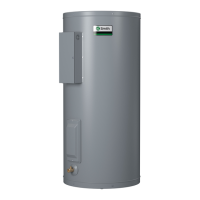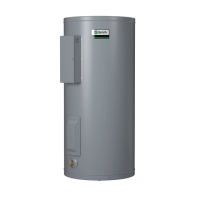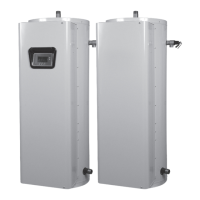Commercial Electric Water Heater Use and Care Guide • 27
3
Remove the plasc element/
thermostat cover. Open the
lower access panel on the
water heater if replacing the lower
thermostat. Fold back the insulaon
and remove the plasc element/
thermostat cover.
4
Make sure the replacement
thermostat matches the
original thermostat.
5
Mark the wires with tape so
you’ll know how to put them
back on.
6
Disconnect the wires from the
bad thermostat and remove
the thermostat from the metal
mounng clip.
7
Install the new thermostat in
the metal mounng clip.
8
Make sure the new thermostat
ts snuggly against the tank.
You should NOT be able to slip
a business card between the
thermostat and the tank. If you can,
bend the thermostat mounng clip
unl the thermostat ts ghtly against
the tank.
9
Aach the wires following the
wiring diagram on the water
heater’s label. Make sure all
wire connecons are ght.
10
Replace the plasc element/
thermostat cover, insulaon,
and access panel.
11
Close the upper access panel
to the electrical juncon box.
12
Restore power to the water
heater. It may take two hours
for the tank to heat up.
Read and follow the operang and
annual maintenance instrucons
provided by the manufacturer of the
T&P Relief Valve (yellow label aached
to T&P Relief Valve). Minerals in the
water can form deposits that cause
the valve to sck or create blocked
passages, making the T&P Relief Valve
inoperave. Follow these guidelines:
• At least annually, operate the
T&P Relief Valve manually to
ensure the waterways are clear
and the valve mechanism moves
freely (above). Before operang
the valve manually, check that
it will discharge in a place for
secure disposal. If water does not
ow freely from the end of the
discharge pipe, turn OFF the power
to the water heater. Call a qualied
person to determine the cause.
• Aer manually operang T&P
Relief Valve, remove any water in
the drain and wipe away any water
from the heater.
Figure 38 - T&P Relief Valve
• At least every ve years, have a
qualied person inspect the T&P
Relief Valve and discharge pipe.
Damage caused by corrosive water
condions, mineral deposits, or other
problems can only be determined
when a qualied person removes
and inspects the valve and its
components.
• Note that a dripping T&P Relief
Valve is usually caused by the water
pressure being too high or the lack of
a Thermal Expansion Tank. If your T&P
Relief Valve drips, see page 23.
MAINTENANCE

